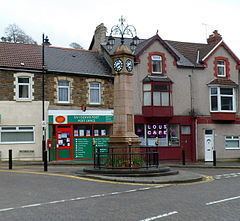OS grid reference ST115905 Country Wales Postcode district CF83 Local time Wednesday 3:58 PM | Sovereign state United Kingdom Dialling code 029 | |
 | ||
Weather 12°C, Wind S at 21 km/h, 93% Humidity | ||
Senghenydd colliery disaster 100 years on
Senghenydd (Welsh: Senghennydd) is a village in the Aber valley, roughly four miles north-west of the town of Caerphilly. Traditionally within the county of Glamorgan it is in the community of Aber Valley in the county borough of Caerphilly, Wales. The population of the Aber Valley in the United Kingdom Census 2001 was 6,696.
Contents
- Senghenydd colliery disaster 100 years on
- Map of Senghenydd Caerphilly UK
- Origin of the name
- History
- Early History
- Coal mining
- Health research
- Transport
- Sport
- Notable people
- References
Map of Senghenydd, Caerphilly, UK
Origin of the name
The name derives originally from the name Sangan + suffix ydd, probably meaning "the land or territory associated with Sangan". The suffix 'ydd' is often used in Welsh, following a personal name, to denote ownership, as in 'Meirionnydd' or 'Eifionydd'.
Historically the name has appeared in a number of different forms, including: 'Seinhenit' (c.1179), 'Seighenith' (c1.194), 'Seynghenyth' (1271), 'Senghenyth' (1314), 'Seynthenneth' (1476), 'Seignhenith Suptus et Supra Cayach' (1578–84).
Alternatively, the name may be a spelling variant, from 1326, of 'Seint Genith', from Saint Cenydd. The local church and school have taken this name, as has the nearby 20th-century settlement of Trecenydd.
History
Senghenydd was originally a rural farming community, which became industrialised with the discovery of coal in the late 19th century. With the closure of the coal pits in the second half of the twentieth century, most people in the town now commute outside the Aber Valley for employment.
Early History
Tradition states that there was a monastery built in the area surrounding the town built by St Cennydd; whilst this is disputed, the area Senghennydd was named after him. The son of Cennydd, St Ffili is said to built a fort in the area, making the name of Caerphilly (Ffili's Fort in the welsh language).
The town was also a stronghold for the Welsh during the late 11th century. By the middle of the 12th century, it remained under Welsh hands and the Welsh chieftain Ifor Bach (hence the name of the local welsh school in the town). Ifor Bach's son, Gruffydd ap Rhys was the last Welsh lord of the town before the English nobleman Gilbery de Clare, builder of Caerphilly Castle, gained control.
Coal mining
Senghenydd, along with its neighbouring town Abertridwr, make up the majority of the Aber Valley, and became urbanised in the 1890s, when the Universal (1891) and Windsor collieries were sunk in this region of the South Wales Coalfield.
The Universal Colliery at Senghenydd suffered the first of two major gas and coal dust explosions on 24 May 1901. Damage was sustained to both shafts, resulting in a restricted rescue attempt, and 81 of the 82 men working in the mine were killed.
On the 14 October 1913, Senghenydd suffered the worst mining disaster in Britain's history, when a second gas explosion occurred at the Universal Colliery, resulting in the loss of 439 lives, plus one rescuer. Many of the surviving miners went back to help their workmates who were either trapped or buried alive.
Universal Colliery was finally closed on Friday 30 March 1928 (except for a ventilation shaft) with the loss of 2500 jobs.
Health research
Men from Senghenydd participate in one of the world's longest running epidemiology studies – The Caerphilly Heart Disease Study. Since 1979, a representative sample of adult males born between 1918 and 1938, living in Caerphilly and the surrounding villages of Abertridwr, Bedwas, Machen, Senghenydd and Trethomas, have participated in the study. A wide range of health and lifestyle data have been collected throughout the study and have been the basis of over 400 publications in the medical press. A notable report was on the reductions in vascular disease, diabetes, cognitive impairment and dementia attributable to a healthy lifestyle.
Transport
Senghenydd is served by the B4263 road to Caerphilly, and connects to Nelson via roads over Mynydd Eglwysilan to the north.
Sport
Senghenydd Rugby Football Club is a rugby union club affiliated to the Welsh Rugby Union who have played in the town since 1898.
